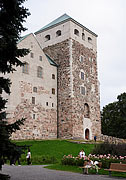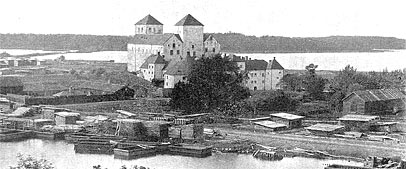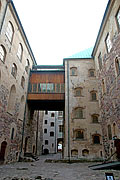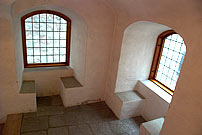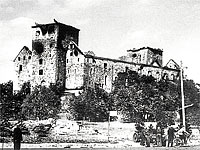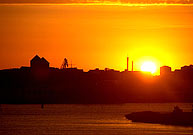Castle of Turku (Åbo)
The first fortification on the place of the present castle appeared in the 1280th, during the Second Crusade, during which Finland became part of Sweden state. On a small rocky island in the mouth of the Aura river, a small rectangular strengthening with sizes 59x38 m. was hastily erected. The fortress was used as a base for Swedish military and administrative activities in the region, as well as the royal residence of the governor of Finland (prefectus Finlandiae). The first on this post was the governor Carl Gustafsson.
The fortification had two powerful towers with gates, a residential building, warehouses, barracks, and a church. Judging by the nature of the masonry, the first builders of Turku were from Gotland. The island on which the fortification was built over time, due to the rise of the Baltic Shield, now connected with the mainland.
During the reign of Duke Valdemar (1302-1318), the son of the Swedish king Magnus III, the fortification of Abo was thoroughly rebuilt and turning it into an impressive Castle. The height of the walls and towers was increased significantly, and inside the courtyard were built residential and auxiliary premises. In 1347 and 1351, King Magnus Erikson visited in the castle. These were the first visits to Turku by crowned heads.
The first siege of the castle occurred during the civil war in Sweden between Albrecht of Mecklenburg and the aforementioned King Magnus. The Castle was in blockade of Prince Albrecht's troops for almost 8 months, after which it was taken and burned by them. This disaster happened in 1365, but soon, by order of the magnate Bo Jonsson Grip, who was then the governor of Finland, the Castle was restored and by the beginning of the 15th century it had more than 40 rooms and halls.
In the 15th century the Castle changed its owners like gloves: King Eric of Pomerania lived here, then Karl Knutsson Bunde, the ruler of Finland, then Eric Axelson Tott laid his paw on the Castle in 1441, and it found itself in the power of the Danes, in 1448 Bunde recaptured the Castle. In 1472-1499 the castle was owned by Sten Sture the Elder and at that time the Castle acquired its current appearance.
In 1530 and 1555 King Gustav Vasa lived in the castle for some time during his visit to Finland. Before his last visit, the royal apartments in the castle were thoroughly renovated and rebuilt in a luxurious 'Renaissance' style.
Vaza's son Johan became Duke of Finland in 1556. In 1562, he arrived in Turku with his wife, the Polish princess Katharina of Jagiellon. They lived in a big way in the castle - receptions, balls, tournaments - in a word, it was a real 'Versailles of the north' here. This was the peak of the castle's heyday. But all good things come to an end quickly. Less than a year later, the troops of Johan's brother, King Eric XIV, besieged the Castle, and the owner himself, together with his illustrious wife, went to the casemates of Gripsholm Castle in Sweden.
Ironically, King Eric himself in 1570-1571, in turn, spent some time in the prison of Turku Castle, after which brother Johan sent him to Kastelholm, in Aland, and then to Castle Orbyhus near Uppsala, where Eric died after eating soup with arsenic. Yes, not all was well in the royal family of Gustav Vasa...
In 1614 the Castle was visited by King Gustav II Adolf, and right during the royal visit the Castle burned down. As they say in Finland, 'we just had a good time...'
By 1623, the Castle was renovated, and it housed the local court of appeal, and in 1635 there was the residence of the ruler of Finland and his administration. In 1637-40 and 1648-51 the famous Per Brahe, governor general and count, who founded many new cities in Finland, lived here, for which he is still honored and respected here.
During the difficult trials of the Great Northern War from 1713 to 1721, Russian troops stationed in the Castle. After the hardships of the war, the Castle was in decline and was only suitable for setting up as a prison. This was done in 1770, and prisoners inhabited the castle’s dungeons right up to 1891. In addition, there was a granary here, as well as a state distillery.
During the Russian rule of 1809-1918, the castle at one time housed an arsenal, barracks for sailors of the skerry flotilla, and, as usual, the provincial prison.
In 1881, the historical museum of the city of Turku in the ancient Castle opened its doors to visitors. Since the 1920s, large-scale archaeological research has been done. It seemed that a new era of prosperity for the ancient building had begun, but... On June 25, 1941, during a massive Soviet air raid on the port and city, Turku Castle burned down.
Restoration work began soon after the war and was generally completed by 1961. The Castle was restored partly in medieval, partly in Renaissance form, according to the design and direction of the Finnish functionalist architect Erik Bruggman. In 1975-86 the fortress courtyard was restored, in 1987-93 a conference room and rooms on the top floor of the main building were restored too. Currently, the ancient building has been completely restored and become the main attraction of southwestern Finland.
Impressions
The functional approach in Finnish architecture is an interesting thing, whatever one may say, but it seemed to me that when using it in the restoration of medieval buildings one should know when to stop. That is, concrete floors, stairs, lamps and double-glazed windows surrounded by truly medieval walls are somehow not quite 'comme il faut' (i.e., bad). This Castle has something to compare with, for example, the Swedish Marstrand near Gothenburg is much more authentic, despite the total restoration (although it was not bombed in 1941).
On the other hand, again, we have an impressive multifunctional building just in the city center, right next to the ferry terminal - a museum, cultural center, exhibition area, and just a place where you can hide from the rain. It is not a dead ruin, but a building useful to the city and common people, interesting in historical terms and simply beautiful in its appearance...
Resume: it would be stupid to visit Turku and not visit this Castle. At least an hour and a half...
Land forts and fortress:
Bip Castle Gatchina Ivangorod Izborsk Kexholm Kirillov Monastery Koporye Novgorod Pechorskiy Monastery Peter&Paul Fortress Porkhov Pskov Schlisselburg Staraya Ladoga Tikhvin Vyborg Hameenlinna Hamina Kastelholm Kymenlinna Lappaenranta Raseborg Castle Savonlinna Tavetti Turku Visby Fredrikstadt Fredriksten Hegra Fort Hoytorp Fort Arensburg Narva Tallinn Antipatris Caesarea Jerusalem Latrun Fort Masada
Sea forts and fortresses:
Alexander Fort Ino Fort Krasnaya Gorka Fort Kronstadt: Kotlin isl. Kronstadt: North Forts Kronstadt: South Forts Trongsund Hanko Svartholm Sveaborg Marstrand Siaro Fort Vaxholm Oscarsborg
Artillery batteries and individual guns:
Coastal Artillery Hemso Fort
Fortified areas and defensive lines:
Karelian Fortified Area (KaUR) KrUR Leningrad Mannerheim Line Nevsky Bridgehead VT Line Harparskog Line Salpa Line Gothland
Russian
S e a r c h All news

